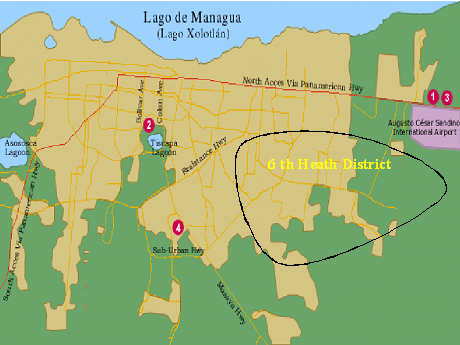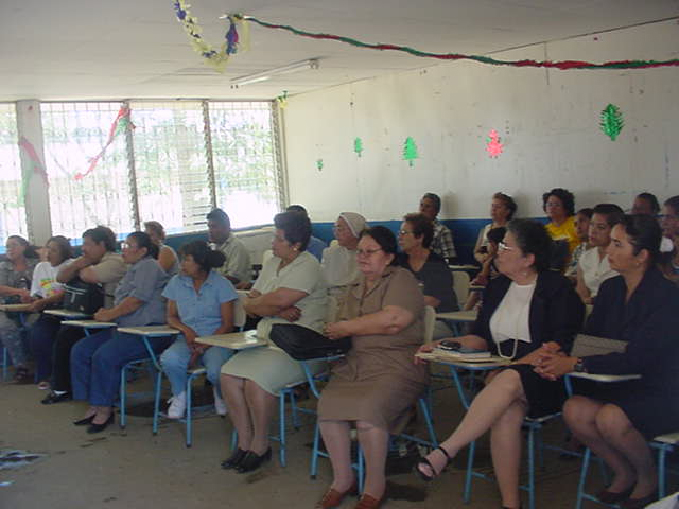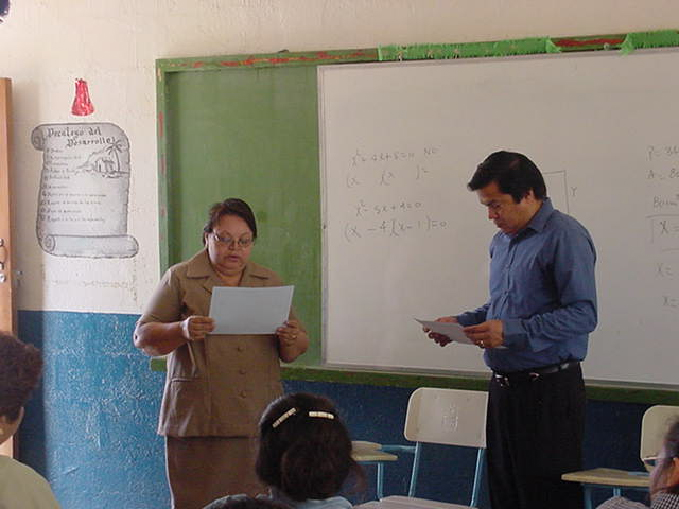

Map of the capital city of Managua. Area of the study circled in black
Nicaragua, Latin America
| Centres: | Phase: | PI: | Age Groups |
|---|---|---|---|
| Managua | 3 | Dr José Félix Sánchez | 13-14, 6-7 |
National Coordinator:
Roles:
- National Coordinator for Nicaragua
- Phase Three Principal Investigator for Managua
Dr José Félix Sánchez

Pediatric Pulmonologist, Director of the Department of Medicine and Pulmonology
Children’s Hospital “Manuel de Jesus Rivera”,
National Referral Hospital of Pediatrics in Nicaragua
District V, Managua,
Nicaragua
Why was this centre selected for ISAAC?
I found out about ISAACphase III by Dr. Manuel Soto Quiros, who was my mentor during my Pulmonology fellowship in Costa Rica. Dr Quiros and Dr. Lars Å Hanson, Department Clinical Immunology, Göteborg University, Sweden, both were involved in the decision that Nicaragua participated in the study. Nicaragua didn’t count with prevalence studies of asthma or allergies. Our country could participate in the phase III of ISAAC thanks to their collaboration.
In the survey on Conditions of Life (EMNV'98) it was found that 64.8% of the families in Nicaragua live in situation of poverty, or extreme poverty and that only one out of four homes satisfies its basic necessities. Managua, as the capital of Nicaragua, have the major density population, were the industrial development is settled. However, behind the acute conditions the chronic diseases appear, but in the developing countries they are often not noticed, diagnosed and properly treated. Such diseases may, because of their chronic nature, severely impair growth and development as well as educational capacity in children. They will also affect the whole family in many ways, not least its economy. The hospitalization rates in children with asthma have been increasing in Nicaragua, and we didn’t count with studies that that could measure the prevalence of symptoms and severity among our population.
The area of study was District VI of Managua (Ministry of Health), located in the eastern part of Managua (Fig 1). It has an area of 42 sq km. The total population is estimated to 146,050 inhabitants; of those 65,722 are children less than 15 years old.
The VI District of Managua was chosen because this is the city area where most of the poor people live, in “barrios” and settlements. The epidemiological profile shows a high incidence of respiratory diseases and acute diarrheas. There is a higher prevalence of malnutrition and parasitism. The sewer and drainage structures are deficient. There are unsuitable potable water services, with inappropriate liquid waste elimination. Many families do not have drain and waste water installation of the people use latrines. The garbage collection service is deficient. The electricity service is inappropriate. Their health care service is principally provided by the State.

Fig 1. Map of the capital city of Managua. Area of the study circled in black.
Our experience of ISAAC
The ISAAC core questionnaires were translated into Spanish, according to defined guidelines, including the familiar terminology of the local community, such as “silbido”, “lira” referring to wheezing . At first we applied a pilot study for the questionnaires that was reviewed by Dr. Manuel Soto Quirós, Costa Rica National Coordinator for ISAAC. We didn’t use the videos mode.
School Principals that participated were very enthusiastic and their collaboration was very important to achieve the study. We had good acceptance from families and children, 95% of questionnaires were sent back complete from parents.
Impact of ISAAC in our country
Before ISAAC data was insufficient, it was the first study for asthma and allergies in Nicaragua, and it marked the beginning for similar studies in other areas of our country, such as the rural areas. Evenly it initiated the development of health and education strategies for the accurate diagnose and treatment for these diseases.
Acknowledgements
This study was conducted with the guidance of Dr. Manuel Soto-Quiros pediatric pulmonologist, from the National Children's Hospital of Costa Rica “Carlos Saenz” and Dr. Lars Å Hanson Department Clinical Immunology, Göteborg University, Sweden. Both were involved in the decision to develop the study, translation of the instrument, pilot study, school selection, monitoring collection of the questionnaires and finally the recording of the information according to the ISAAC protocol for the phase III.
For this study the technical and methodological quality were counted with the financial support of SAREC and VARDAL, both Swedish institutions that support scientific and development in Latin America.
For its realization we had the approval and collaboration of the Ministry of Health of Nicaragua and Ministry of Education of the government of Nicaragua.
Eduardo Parrales, M.D, was the Ministry of Health director of the area VI where we developed the study. He was a very important support to achieve the objectives.
For the collection of the questionnaires, we hired two registered nurses, Lic. Alba Sandoval and Lic. Martha Garcia who made an excellent work in the field.
We appreciate all the support and coordination of the school directors and teachers with the study. As well children and their families, they were very interested in the study and the results.
Click the link to the left to see our photos.


Map of the capital city of Managua. Area of the study circled in black


Evaluation meeting at the end of the study with the school directors and teachers. From left to right: District 6 Ministry of Education Director, in the middle Eduardo Parrales, M.D. and at the right Jose Felix Sanchez, M.D.


Teachers and school directors that contributed in the study.


Sports utilities were given to the participating schools for their sports teams. At the left Jose Felix Sanchez, M.D.


Sports utilities were given to the participating schools for their sports teams. At the left Jose Felix Sanchez, M.D.


Dr. Jose Felix Sanchez received a recognition certificate from the authorities of the Nicaragua Ministry of Education for his work in the health and welfare of the school children and the community.


Dr. Jose Felix Sanchez received a recognition certificate from the authorities of the Nicaragua Ministry of Education for his work in the health and welfare of the school children and the community.
